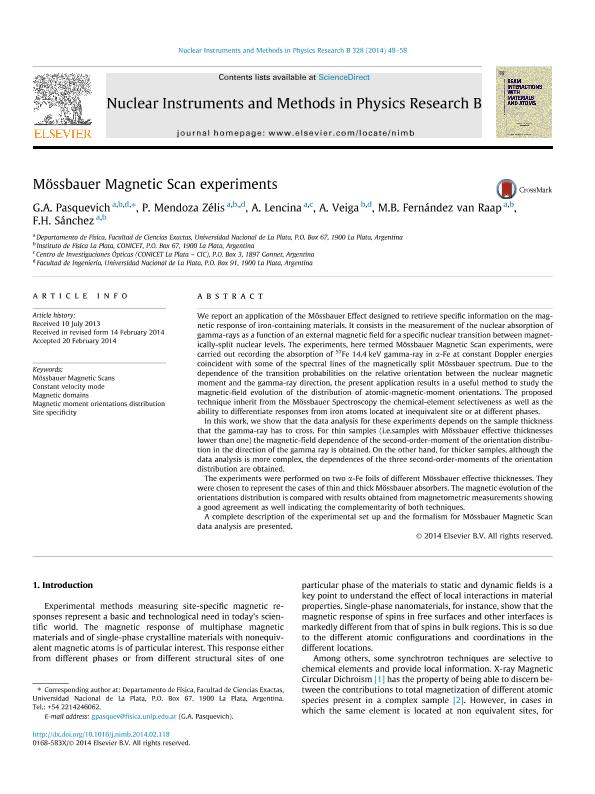Artículo
Mössbauer Magnetic Scan experiments
Pasquevich, Gustavo Alberto ; Mendoza Zélis, Pedro
; Mendoza Zélis, Pedro ; Lencina, Alberto Germán
; Lencina, Alberto Germán ; Veiga, Alejandro Luis
; Veiga, Alejandro Luis ; Fernandez Van Raap, Marcela Beatriz
; Fernandez Van Raap, Marcela Beatriz ; Sanchez, Francisco Homero
; Sanchez, Francisco Homero
 ; Mendoza Zélis, Pedro
; Mendoza Zélis, Pedro ; Lencina, Alberto Germán
; Lencina, Alberto Germán ; Veiga, Alejandro Luis
; Veiga, Alejandro Luis ; Fernandez Van Raap, Marcela Beatriz
; Fernandez Van Raap, Marcela Beatriz ; Sanchez, Francisco Homero
; Sanchez, Francisco Homero
Fecha de publicación:
06/2014
Editorial:
Elsevier Science
Revista:
Nuclear Instruments and Methods in Physics Research B: Beam Interactions with Materials and Atoms
ISSN:
0168-583X
Idioma:
Inglés
Tipo de recurso:
Artículo publicado
Clasificación temática:
Resumen
We report an application of the Mössbauer Effect designed to retrieve specific information on the magnetic response of iron-containing materials. It consists in the measurement of the nuclear absorption of gamma-rays as a function of an external magnetic field for a specific nuclear transition between magnetically-split nuclear levels. The experiments, here termed Mössbauer Magnetic Scan experiments, were carried out recording the absorption of 57Fe 14.4 keV gamma-ray in a-Fe at constant Doppler energies coincident with some of the spectral lines of the magnetically split Mössbauer spectrum. Due to the dependence of the transition probabilities on the relative orientation between the nuclear magnetic moment and the gamma-ray direction, the present application results in a useful method to study the magnetic-field evolution of the distribution of atomic-magnetic-moment orientations. The proposed technique inherit from the Mössbauer Spectroscopy the chemical-element selectiveness as well as the ability to differentiate responses from iron atoms located at inequivalent site or at different phases. In this work, we show that the data analysis for these experiments depends on the sample thickness that the gamma-ray has to cross. For thin samples (i.e.samples with Mössbauer effective thicknesses lower than one) the magnetic-field dependence of the second-order-moment of the orientation distribution in the direction of the gamma ray is obtained. On the other hand, for thicker samples, although the data analysis is more complex, the dependences of the three second-order-moments of the orientation distribution are obtained. The experiments were performed on two a-Fe foils of different Mössbauer effective thicknesses. They were chosen to represent the cases of thin and thick Mössbauer absorbers. The magnetic evolution of the orientations distribution is compared with results obtained from magnetometric measurements showing a good agreement as well indicating the complementarity of both techniques. A complete description of the experimental set up and the formalism for Mössbauer Magnetic Scan data analysis are presented.
Archivos asociados
Licencia
Identificadores
Colecciones
Articulos(CCT - LA PLATA)
Articulos de CTRO.CIENTIFICO TECNOL.CONICET - LA PLATA
Articulos de CTRO.CIENTIFICO TECNOL.CONICET - LA PLATA
Articulos(CIOP)
Articulos de CENTRO DE INVEST.OPTICAS (I)
Articulos de CENTRO DE INVEST.OPTICAS (I)
Articulos(IFLP)
Articulos de INST.DE FISICA LA PLATA
Articulos de INST.DE FISICA LA PLATA
Citación
Pasquevich, Gustavo Alberto; Mendoza Zélis, Pedro; Lencina, Alberto Germán; Veiga, Alejandro Luis; Fernandez Van Raap, Marcela Beatriz; et al.; Mössbauer Magnetic Scan experiments; Elsevier Science; Nuclear Instruments and Methods in Physics Research B: Beam Interactions with Materials and Atoms; 328; 6-2014; 48-58
Compartir
Altmétricas



